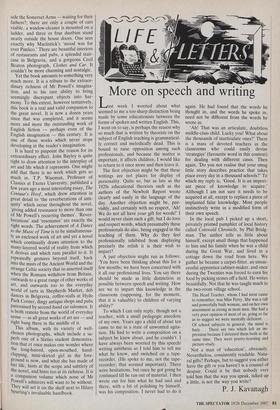Seeing secret harmonies
Allan Massie
THE ALBUM OF ANTHONY POWELL'S DANCE TO THE MUSIC OF TIME edited by Violet Powell, with a preface by Anthony Powell and an introduction by John Bayley Thames & Hudson, f14.95 Everyone who dotes on A Dance to the Music of Time must recall that moment on the Great West Road to Maidenhead when Nicholas and Jean first embrace just a few hundred yards beyond the point where the electrically illuminated young lady in a bathing dress dives eternally through the. petrol-tainted air; night and day, winter and summer, never reaching the water of the pool to which she endlessly glides — an image which is sexy and sombre, with a wonderfully Proustian anticipation of a fulfilment that can never be achieved. And here she is, on page 65 of this album Jantzen Swimming Suits, her hands stretching out towards the 't' of Jantzen and never quite reaching it.
In the introduction to this delicious album, John Bayley writes: 'nothing shows the complete originality of Powell's techni- que more than the way his fiction imitates memoir, and almost in a double sense, like a trompe l'oeil painting...' his novel being `an anecdote arranging itself it the elabo- rate composition of a picture.' This is exactly right — and the whole of this introductory essay is the most marvellously acute exploration of the nature of Powell's intricate intertwining of art and reality; of a quality that takes one by surprise in what looks at first glance like a rather indulgent picture-book.
Perhaps it started like that, when Lady Violet began collecting photographs which might illustrate moments in her husband's novel; the sort of enterprise like the enactment of Pride at Stourwater by Isobel Jenkins and Anne Umfraville which dis- played 'the nursery and playroom life of generations of "great houses": the abound- ing physical vitality of big aristocratic families... [their] uninhibited delight in "dressing up" ...'. And of course the book can be enjoyed in just that way, as an old family album. Many of the photographs are delightful. There is one for instance of Pimlico in the Thirties, with children hanging about out- side the Somerset Arms — waiting for their fathers?; there are only a couple of cars visible, a window-cleaner is mounted on a ladder, and three or four dustbins stand neatly outside the house doors. One sees exactly why Maclintick's 'mood was for ever Pimlico.' There are beautiful interiors of restaurants and pubs, a splendid stair- case in Belgravia, and a gorgeous Cecil Beaton photograph, Clothes and Car. It couldn't be more charming and nostalgic.
Yet the book amounts to something very much more. It is a tribute to the extraor- dinary richness of Mr Powell's imagina- tion, and to his rare ability to bring seemingly discrepant objects into har- mony. To this extent, however tentatively, this book is a real and valid companion to the great novel. It is now a dozen years since that was completed, and it seems more and more the outstanding work of English fiction — perhaps even of the English imagination — this century. It is one of those works which never stops developing in the reader's imagination.
It is hard to pinpoint the reason for its extraordinary effect. John Bayley is quite right to draw attention to the interplay of art and life which it represents. One might add that there is no work which gets so much in. T.P. Wiseman, Professor of Classics at Exeter University, published a few years ago a most interesting essay, The Centaur's Hoof, which drew attention in great detail to 'the reverberations of anti- quity' which occur throughout the novel, `giving added resonance to more than one of Mr Powell's recurring themes'. 'Rever- berations' and 'resonance' are exactly the right words. The achievement of A Dance to the Music of Time is to be simultaneous- ly an enclosed work of art and yet a novel which continually draws attention to the many-layered world of reality from which it derives and which runs parallel to it. It repeatedly gestures beyond itself, back into the mists of the Ancient World and the strange Celtic society that re-asserted itself when the Romans withdrew from Britain, outwards to a great range of other works of art, and outwards too to the everyday world of tarts in Shepherds Market, deb dances in Belgravia, coffee-stalls at Hyde Park Corner, dingy antique shops and pubs patronised by second-hand car salesmen. It is both remote from the world of everyday sense — as all great works of art are — and right bang there in the middle of it. This album, with its variety of well- Chosen photographs, which include a su- perb one of a Sixties student demonstra- tion that at once makes one wonder where the long-haired, open-mouthed, hand- clapping, mini-skirted girl in the fore- ground is now, and what she has made of her life, hints at the scope and subtlety of the novel, and hints too at its richness. It is a companion volume which none of Mr Powell's admirers will want to be without. They will set it on the shelf next to Hilary Spurling's invaluable handbook.











































































































 Previous page
Previous page